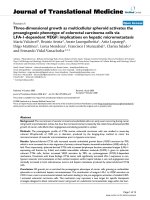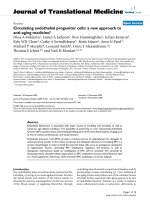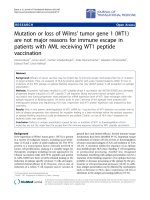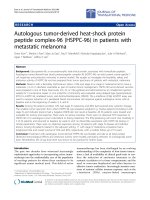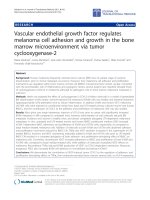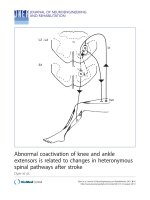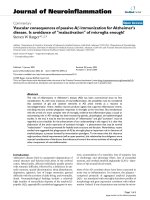báo cáo hóa học: " Vascular endothelial growth factor-A and chemokine ligand (CCL2) genes are upregulated in peripheral blood mononuclear cells in Indian amyotrophic lateral sclerosis patients" pot
Bạn đang xem bản rút gọn của tài liệu. Xem và tải ngay bản đầy đủ của tài liệu tại đây (476.84 KB, 6 trang )
SHOR T REPOR T Open Access
Vascular endothelial growth factor-A and
chemokine ligand (CCL2) genes are upregulated
in peripheral blood mononuclear cells in Indian
amyotrophic lateral sclerosis patients
Pawan K Gupta
†
, Sudesh Prabhakar
†
, Chandrika Abburi, Neel K Sharma and Akshay Anand
*
Abstract
Background: We have earlier shown that protein levels of vascular endothelial growth factor-A (VEGF-A) and
chemokine ligand-2 (CCL2) were elevated in Indian amyotrophic lateral sclerosis (ALS) patients. Here, we report the
mRNA levels of VEGF-A and CCL2 in Indian ALS patients since they display extended survival after disease onset.
Methods: VEGF-A and CCL2 mRNA levels were measured in peripheral blood mononuclear cells (PBMCs) of 50
sporadic Indian ALS patients using Real Time Polymerase Chain Reaction (PCR) and compared with normal controls
(n = 50). Their levels were adjusted for possible confounders like cigarette smoking, alcohol and meat
consumption.
Results: VEGF-A and CCL2 mRNA levels were found to be significantly elevated in PBMCs in ALS patients as
compared to controls. PBMCs from definite ALS revealed higher VEGF-A mRNA expression as compared to
probable and possible ALS. CCL2 mRNA levels were found to be unaltered when definite, probable and possible
ALS were compared. PBMCs from patients with respiratory dysfunction showed much higher VEGF-A and CCL2
elevation when compared to patients without respiratory dysfunction. No association of smoking, alcohol and
meat consumption with VEGF-A and CCL2 was observed after analyzing the data with univariate and multivariate
analysis.
Conclusion: VEGF-A and CCL2 mRNA upregulation in PBMCs may have a clinico-pathological/etiological/
epidemiological association with ALS pathogenesis. The cross-cultural and cross-ethnic investigations of these
molecules could determine if they have any role in enhancing the mean survival time unique to Indian ALS
patients.
Introduction
Amyotrophic lateral sclerosis (ALS) is a neurodegenera-
tive disorder characterized by selective loss of motor neu-
ron. Vascular endothelial growth factor-A (VEGF-A) is a
dimeric secreted polypeptide that was discovered first in
the VEGF family which also includes placental growth
factor (PLGF), VEGF-B, VEGF-C, VEGF-D and VEGF-E.
VEGF-A stimulates growth of blood vessels during
embryonic development and helps in proliferation of
blood collaterals in diseased conditions including ALS
through a tyrosine kinase dependent VEGF receptor-2
(VEGFR2) [1]. Apart from angiogenesis, VEGF-A is sug-
gested to exert direct neuroprotection via VEGFR2 and
neuropilin-1 (NP-1) in animal models and patients of var-
ious neurodegenerative disorders [2]. Mice having homo-
zygous deletion in hypoxia response element (HRE) of
VEGF-A promoter (VEGF
δ/δ
) were reported to dev elop
symptoms like classical ALS [3] and conversely, intrathe-
cal transplantation of stem cells overexpressing VEGF-A
delays the onset and progression of ALS in superoxide
dismutase-1 (SOD1) mutated transgenic mouse by
downregulating proapoptotic proteins and activating
* Correspondence:
† Contributed equally
Department of Neurology, Post Graduate Institute of Medical Education and
Research (PGIMER), Chandigarh-160012, India
Gupta et al. Journal of Neuroinflammation 2011, 8:114
/>JOURNAL OF
NEUROINFLAMMATION
© 2011 Gupta et al; licensee BioMed Central Ltd. This is an Open Access article distributed under the terms of the Creative Commons
Attribution License ( which permits unrestricted use, distribution, and reproduction in
any medium, provided the original work is properly cited.
phosphatidylinositol 3-kinase/protein kinase B (PI3-K/
Akt) anti apoptotic pathway [4]. On the other hand, che-
mokine ligand-2 (CCL2), a proinflammatory molecule,
may impart neuroprotection in ALS against glutamate
induced excitotoxicity either by reducing release of gluta-
mate and/or increasing efficiency of astrocytes to clear
glutamate at synapses [5].
Indian ALS patients are known to exhib it significantly
extended survival duration after disease onset as com-
pared to Western ALS patients [6-8]. We recently
reported that augmented biofluids VEGF-A and CCL2
protein may be associated with increased survival dura-
tion of Indian ALS patients [9]. We now measured the
mRNA expression of VEGF-A and CCL2 in peripheral
blood mononuclear cells (PBMCs) of these patients.
Subjects and methods
50 patients, born in North India and diagnosed with
ALS were included from a convenience sample of Neu-
rology outpatient, post graduate institute of medical
education and research (PGIMER), Chandigarh after
obtaining informed consent as a part of research proto-
col as per institute e thical committee guidelines (No.
7055-PG-1Tg-05/4348-50). Based on the “El Escorial cri-
teria” , there were 25 definite ALS patients, 15 indivi-
duals were probable ALS and remaining 10 were
possible ALS at the time of sample collection. ALS-func-
tional rating score-revised (ALSFRS-R) revealed that 11
patients had respiratory dysfunction such as orthopnea
and dyspnea accompanied with other respiratory insuffi-
ciencies, although none of the patients needed respira-
tory support [10]. ALS patients with history of diabetic
neuropathy, glaucoma, pre-eclampsia, stroke, those
receiving riluzole, anti inflammatory drugs, antioxidants
or other treatment were excluded. 50 genetically unre-
lated healthy normal controls without any apparent
health problems such as hypertension, diabetes, heart
disease etc were included for comparison. The subjects
were categorized as cigarette smokers and never smo-
kers, alcohol consumers and nonalcoholics, vegetarian
and non-vegetarian (or meat consumers) using a stan-
dard questionnaire as per published criteria [11]. The
clinical and demographic details of subjects published
earlier [9] have also been reproduced here in Table 1.
PBMCs were i solated as per Histopaque-1077 ( Sigma,
USA) datasheet. Briefly, 6.0 ml blood was collected from
each subject and layered on equal volume of Histopa-
que-1077. It was then centrifuged at 1800 rpm f or 30.0
mins at room temperature and PBMCs were collected
from plasma/Histopaque-1077 interface and preserved
in RNA later (Sigma, USA) at -80°C until used.
Total RNA was extracted from PBMCs using RNAeasy
columns (Qiagen, USA). RNA concentration was mea-
sured by taking absorbance at 260.0 nm. About 500.0 ng
- 5000.0 ng total RNA was used to synthesize cDNA
according to RevertAid™ first strand cDNA kit (Fer-
mentas, USA).
Real Time Polymerase Chain Reaction (PCR) was used
to quantitate expression of VEGF-A and CCL2 mRNA
using published primers [12-14]. Methodology of Real
Time PCR has been elaborated in “Additional File 1“.
Because the data was normally distributed as indicated
by quintile-quintile (Q-Q) plot, unpaired, independent,
2-tailed student t test and one-way analysis of variance
(ANOVA) followed by Fisher’s least significant differ-
ence (LSD) post hoc analysis w as applied for statistical
comparisons. Crude and adjusted odds ratio (OR) was
evaluated by univariate and multivariate logistic regres-
sion respectively to check any possible influence of
smoking, alcohol and meat consumption on VEGF-A
and CCL2 mRNA levels and c
2
(chisquare)testwas
performed to find significance level.
p-value was considered significant at ≤0.05. Statistical
analysis was performed by statistical package and service
solutions (SPSS) 16 software. Results w ere analyzed by
two independent and masked researchers.
Results
Real Time PCR indicates that VEGF-A expression is 77-
fold higher in ALS than control s (Figure 1A; p = 0.0001).
CCL2 mRNA has shown an increment of 9.5-fold in ALS
than controls (Figure 1B; p = 0.005). There was elevated
VEGF-A mRNA expression in definite ALS patients in
comparison to controls, probable and possible ALS (Figure
2A; p = 0.0001, p = 0.029 and p = 0.018 respectively).
Further, both probable and possible ALS pat ients were
shown to have higher VEGF-A than controls (Figure 2A; p
= 0.0001 and p = 0.0001 respectively). However, CCL2
Table 1 Characteristics of the subjects
Subjects Age (y)
†
M/F (n) Age of onset (y) Disease duration
‡
(mo) B/L (n) Smokers (n) Alcohol consumers (n) Non-vegetarian (n)
ALS 47.4 ± 12.4 38/12 46.2 ± 12.8 19.0 ± 12.7 8/42 12 12 20
Controls 40.0 ± 12.8 39/11 10 14 27
Clinical and demographic details of subjects. ALS, amyotrophic lateral sclerosis; n, Number; M, male; F, female; y, years; mo, months; B, bulbar; L, limb; Age, age
of onset, duration of disease are indicated as mean ± standard deviation (SD). † Unpaired, independent 2-tailed student t test analysis showed that mean age
differ significantly among the groups (p = 0.004). ‡ Duration of disease is the interval between appearance of first symptom of ALS and collection of sample. ALS
subjects were asked to provide all clinical and demographic details at the age of disease-onset.
Gupta et al. Journal of Neuroinflammation 2011, 8:114
/>Page 2 of 6
levels did not vary between definite, probable and possible
ALS cases (Figure 2B; p > 0.05).
To find association of respiratory dysfunction, VEGF-
A and CCL mRNA levels were reanalyzed among ALS
patients with respiratory dysfunction and those without
respiratory dysfunction. Significantly increased VEGF-A
and CCL2 was observed in ALS patients with respiratory
dysfunction as compared to patients without respiratory
dysfunction (Figure 3A-B; p = 0.045 and p = 0.021
respectively)
No association of cigarette smoking, alcohol and meat
consumption with VEGF-A (Table 2) and CCL2 (data
notshown)mRNAwasobserved upon univariate and
multivariate analysis.
Discussion
Ithasbeenreportedthatmediansurvivaldurationof
Indian ALS patients is ~9 years after disease onset
which is significantly higher as compared to their Wes-
tern counterparts who survive for 3-6 years after disease
onset [6-8]. Because of this contradicting presentation,
we investigated the levels of VEGF-A and CCL2 among
the Indian ALS patients.
The increased PBMCs VEGF-A and CCL2 expression
in our patients may suggest the pathophysiological
involvement of circulating monocytes and lymphocytes
in ALS. The elevated PBMCs VEGF-A is in contrast to
previous reports where a profound downregulation of
VEGF-A mRNA in SOD1G93A ALS mouse and signifi-
cantly reduced serum and cerebrospinal fluid (CSF)
VEGF-A in ALS patients was observed possibly because
of genetic changes in promoter regions [15-17].
Increased serum and CSF VEGF-A re ported earlier in
ALS and in its differen t clinical subtype with limb onset
and extended disease duration are in agreement with
current results [18,19]. However, some studies have
failed to detect significant change in serum, plasma and
CSF VEGF-A in ALS patients [20,21]. It is believed that
the variable study designs including different molecular
tools, study power, diverse clinical and genetic spectrum
of ALS patients may account for conflicting VEGF-A
levels. The increased PBMCs CCL2 is consistent with
reports where elevated CCL2 mRNA was observed in
spinal cord and skeletal muscles of ALS patient’sautop-
sies and SOD1 mutated ALS mice [14,22].
As VEGF-A and CCL2 are neurotrophic, Indian ALS
patients may enhance VEGF-A and CCL2 expression i n
an attempt to ameli orate excit otoxicity through upregu-
lation of glutamate receptor as reported earlier [5,23].
Increased VEGF-A and CCL2 may promote migration
Figure 1 Relative mRNA expression of VEGF-A (A) and CCL2 (B) in PBMCs of ALS patients. Values are plotted as mean ± SE (Standard
error) in the bar diagram. Data was analyzed by unpaired, independent 2-tailed student t test. # indicates significant difference among the
groups (p < 0.05). Expression of VEGF-A and CCL2 were normalized to expression of endogenous control b-actin. ALS, amyotrophic lateral
sclerosis; VEGF-A, vascular endothelial growth factor-A; CCL2, chemokine ligand-2; PBMCs, peripheral blood mononuclear cells.
Gupta et al. Journal of Neuroinflammation 2011, 8:114
/>Page 3 of 6
and differentiation of VEGF receptor 1 (VEGFR1),
VEGFR2 and chemokine receptor 2 (CCR2) expressing
adult neural progenitor cell into neuronal and gli al phe-
notypes at the site of injury [24,25]. Whether their upre-
gulation represent any compensatory response towards
extended survival of Indian ALS patients should be eval-
uated in future comparable cross-cultural and cross-eth-
nic ALS population where survival is longer. It must be
emphasized that mean survival duration of reported
ALS patients could not be ascertained.
Since elevated CCL2 initiates inflammatory reaction by
increasing production of nitric oxide and other inflam-
matory chemokines from unregulated monocytes/
macrophages [26] and VEGF-A is known to recruit leu-
koc ytes at the site of brain injury by increasing vascular
permeability [27], it is possible that the high VEGF-A
and CCL2 in our ALS patients may exert limited inflam-
matory responses associated with neuroprotection [28].
At this moment, we are not able to state whether t he
increased VEGF-A and CCL2 mRNA is a consequence
of genetic and/or epigenetic changes of upstream
regulatory sequences, altered transcriptional regulation
or amyotrophy and thus the present report lays the
foundation for future studies to screen promoter ele-
ments of VEGF-A and CCL2 in Indian ALS population
for subtle genetic differences. The stress conditi ons, like
respiratory problems, may also modify transcriptional
gene regulation as indicated by increased VEGF-A and
CCL2 mRNA expression in the 11 ALS patients with
respiratory dysfunction and signifies a possible associa-
tion with hypoxia (Figure 3).
Based on existing literature [29,30], elevated VEGF-A
andCCL2indefiniteALSmayrepresentthepossibility
of relatively extensive extra central nervous system
(CNS) involvement and higher degree of nerve endin gs
arborization at neuromuscular junction than probable
and possible ALS, however, neuroanatomical architec-
ture of neuromuscular junction has not been evaluated.
The possibility of increased VEGF-A and CCL2, in defi-
nite ALS due to respiratory dysfunction, may not be
ruled out even though only 28% of all definite ALS
cases presented with respiratory symptoms.
Figure 2 Relative mRNA expression of VEGF-A (A) and CCL2 (B) in PBMCs of definite, probable and possible ALS patients . Values are
plotted as mean ± SE (Standard error) in the bar diagram. Data was analyzed by one-way analysis of variance (ANOVA) followed by Fisher’s least
significant difference (LSD) post hoc test. # indicates significant difference among the groups (p < 0.05). Expression of VEGF-A and CCL2 were
normalized to expression of endogenous control b-actin. Basal VEGF-A mRNA expression in normal control group is represented by x-axis in part
“A”. ALS, amyotrophic lateral sclerosis; VEGF-A, vascular endothelial growth factor-A; CCL2, chemokine ligand-2; PBMCs, peripheral blood
mononuclear cells.
Gupta et al. Journal of Neuroinflammation 2011, 8:114
/>Page 4 of 6
Conclusion
Although it can not be concluded that increased VEGF-
A and CCL2 expression contributes towards enhanced
survival yet the i mportance of clinico-pathological, etio-
logical and epidemiological association of increased
VEGF-A and CCL2 with survival of In dian ALS patients
may not be underestimated and needs further
investigations.
Ethical approval
Ethical approval was obtained by institute ethical com-
mittee, PGIMER, Chandigarh, India - 160012 (No. 7055-
PG-1Tg-05/4348-50).
Additional material
Additional file 1: Real Time Polymerase Chain reaction (PCR).
Methodology of Real Time PCR; PCR cycling conditions and amplicon
size of VEGF-A and CCL2; sequences and references of primers used.
Abbreviations
ALS: amyotrophic lateral sclerosis; ALSFRS-R: ALS functional rating score-
revised; ANOVA: analysis of variance; CCL2: chemokine ligand-1; CCR2:
chemokine receptor-2; CNS: central nervous system; CSF: cerebrosp inal fluid;
EDTA: ethylene diamine tetraacetate; HRE: hypoxia response element; LSD:
least significant difference; mRNA: messenger ribonucleic acid; NMDA: N-
Methyl-D-aspartate; NP-1: neuropilin-1; OR: odds ratio; PBMCs: peripheral
Figure 3 Fold change in expression of VEGF-A (A) and CCL2 (B) in PBMCs of ALS patients with respiratory dysfunction.Valuesare
plotted as mean ± SE (Standard error) in the bar diagram. Data was analyzed by one-way analysis of variance (ANOVA) followed by Fisher’s least
significant difference (LSD) post hoc test. # indicates significant difference among the groups (p < 0.05). Expression of VEGF-A and CCL2 were
normalized to expression of endogenous control b-actin. Basal VEGF-A mRNA expression in normal control group is represented by x-axis in part
“A”. ALS, amyotrophic lateral sclerosis; VEGF-A, vascular endothelial growth factor-A; CCL2, chemokine ligand-2; PBMCs, peripheral blood
mononuclear cells.
Table 2 Crude and adjusted OR for VEGF-A mRNA
OR (95% CI)
†
p* Adj. OR (95% CI)
‡
p*
VEGF-A mRNA
Smoking 0.8 (0.2-4.3) 0.8 1.1 (0.2-6.3) 0.8
Alcohol consumption 1.0 (0.2-4.3) 0.9 0.9 (0.2-4.5) 0.9
Meat consumption 0.8 (0.2-3.0) 0.8 0.8 (0.2-3.3) 0.8
Never smoking/ 1.0 1.0
Nonalcoholic/
Vegetarian**
† Univariate logistic regression was used to calculate crude OR. ‡ Multivaria te
logistic regression was used to adjust the effect of smoking on VEGF-A mRNA
levels with alcohol and meat consumption as covariates. Likewise, effect of
alcohol and meat consumption on VEGF-A is also adjusted for covariates. *c
2
(chi square test) was used to test the level of significance. ** Never smoking,
nonalcoholic and vegetarian diet is considered as reference group. VEGF-A,
vascular endothelial growth factor-A; OR, odds ratio; CI, confidence interval;
Adj, adjusted.
Gupta et al. Journal of Neuroinflammation 2011, 8:114
/>Page 5 of 6
blood mononuclear cells; PCR: polymerase chain reaction; PI3-K:
phosphatidylinositol 3-kinases; SOD1: superoxide dismutase 1; VEGF: vascular
endothelial growth factor; VEGFR1: VEGF receptor-1; VEGFR2: VEGF receptor-
2.
Acknowledgements
We acknowledge ICMR (Indian Council of Medical Research), India, for
providing funds (No. 5/4 - 5/10/Neuro/2005 - NCD - I).
Authors’ contributions
PKG Acquisition of data and writing of manuscript. SP inclusion of patients,
grant PI and clinical scoring. CA Acquisition of data. NKS Statistical analysis.
AA Interpretation and analysis of data, grant co PI and writing and editing
of manuscript. All authors read and approved the final manuscript.
Competing interests
The authors declare that they have no competing interests.
Received: 2 May 2011 Accepted: 9 September 2011
Published: 9 September 2011
References
1. Carmeliet P: Mechanisms of angiogenesis and arteriogenesis. Nat Med
2000, 6:389-395.
2. Storkebaum E, Lambrechts D, Carmeliet P: VEGF: once regarded as a
specific angiogenic factor, now implicated in neuroprotection. Bioessays
2004, 26:943-954.
3. Oosthuyse B, Moons L, Storkebaum E, Beck H, Nuyens D, Brusselmans K,
Van Dorpe J, Hellings P, Gorselink M, Heymans S, Theilmeier G,
Dewerchin M, Laudenbach V, Vermylen P, Raat H, Acker T, Vleminckx V, Van
Den Bosch L, Cashman N, Fujisawa H, Drost MR, Sciot R, Bruyninckx F,
Hicklin DJ, Ince C, Gressens P, Lupu F, Plate KH, Robberecht W, Herbert JM,
Collen D, Carmeliet P: Deletion of the hypoxia-response element in the
vascular endothelial growth factor promoter causes motor neuron
degeneration. Nat Genet 2001, 28:131-138.
4. Hwang DH, Lee HJ, Park IH, Seok JI, Kim BG, Joo IS, Kim SU: Intrathecal
transplantation of human neural stem cells overexpressing VEGF
provide behavioral improvement, disease onset delay and survival
extension in transgenic ALS mice. Gene Ther 2009, 10:1234-1244.
5. Madrigal JL, Leza JC, Polak P, Kalinin S, Feinstein DL: Astrocyte-derived
MCP-1 mediates neuroprotective effects of noradrenaline. J Neurosci
2009, 29:263-267.
6. Nalini A, Thennarasu K, Gourie-Devi M, Shenoy S, Kulshreshtha D: Clinical
characteristics and survival pattern of 1,153 patients with amyotrophic
lateral sclerosis: experience over 30 years from India. J Neurol Sci 2008,
272:60-70.
7. Bradley WG: Commentary on Professor Stephen Hawking’s disability
advice. Annals of Neurosciences 2009, 16:101-102.
8. Sorenson EJ, Stalker AP, Kurland LT, Windebank AJ: Amyotrophic lateral
sclerosis in Olmsted County, Minnesota, 1925 to 1998. Neurology 2002,
59:280-282.
9. Gupta PK, Prabhakar S, Sharma S, Anand A: Vascular endothelial growth
factor-A (VEGF-A) and chemokine ligand-2 (CCL2) in Amyotrophic
Lateral Sclerosis (ALS) patients. Journal of Neuroinflammation 2011, 8:47.
10. Cedarbaum JM, Stambler N, Malta E, Fuller C, Hilt D, Thurmond B,
Nakanishi A: The ALSFRS-R: a revised ALS functional rating scale that
incorporates assessmentsof respiratory function. BDNF ALS Study Group
(Phase III). J Neurol Sci 1999, 169:13-21.
11. Prabhakar S, Vinish M, Das CP, Anand A: Occurrence of PARK2 Mutations
in a Never-Smoker Population with Parkinson’s Disease in North India.
Neuroepidemiology 2010, 35:152-159.
12. Meister B, Grünebach F, Bautz F, Brugger W, Fink FM, Kanz L, Möhle R:
Expression of vascular endothelial growth factor (VEGF) and its
receptors in human neuroblastoma. Eur J Cancer 1999, 35:445-449.
13. Ebihara N, Yamagami S, Yokoo S, Amano S, Murakami A: Involvement of C-
C chemokine ligand 2-CCR2 interaction in monocyte-lineage cell
recruitment of normal human corneal stroma. J Immunol 2007,
178:3288-3292.
14. Henkel JS, Engelhardt JI, Siklos L, Simpson EP, Kim SH, Pan T, Goodman JC,
Siddique T, Beers DR, Appel SH: Presence of dendritic cells, MCP-1, and
activated microglia/macrophages in amyotrophic lateral sclerosis spinal
cord tissue. Ann Neurol 2004, 55:221-235.
15. Lu L, Zheng L, Viera L, Suswam E, Li Y, Li X, Estévez AG, King PH: Mutant
Cu/Zn-superoxide dismutase associated with amyotrophic lateral
sclerosis destabilizes vascular endothelial growth factor mRNA and
downregulates its expression. J Neurosci 2007, 30:7929-38.
16. Lambrechts D, Storkebaum E, Morimoto M, Del-Favero J, Desmet F,
Marklund SL, Wyns S, Thijs V, Andersson J, van Marion I, Al-Chalabi A,
Bornes S, Musson R, Hansen V, Beckman L, Adolfsson R, Pall HS, Prats H,
Vermeire S, Rutgeerts P, Katayama S, Awata T, Leigh N, Lang-Lazdunski L,
Dewerchin M, Shaw C, Moons L, Vlietinck R, Morrison KE, Robberecht W,
Van Broeckhoven C, Collen D, Andersen PM, Carmeliet P: VEGF is a
modifier of amyotrophic lateral sclerosis in mice and humans and
protects motoneurons against ischemic death. Nat Genet 2003,
34:383-394.
17. Devos D, Moreau C, Lassalle P, Perez T, De Seze J, Brunaud-Danel V,
Destée A, Tonnel AB, Just N: Low levels of the vascular endothelial
growth factor in CSF from early ALS patients. Neurology 2004,
62:2127-2129.
18. Nygren I, Larsson A, Johansson A, Askmark H: VEGF-A is increased in
serum but not in spinal cord from patients with amyotrophic lateral
sclerosis. Neuroreport 2002, 13:2199-2201.
19. Iłzecka J: Cerebrospinal fluid vascular endothelial growth factor in
patients with amyotrophic lateral sclerosis. Clin Neurol Neurosurg 2004,
106:289-93.
20. Cronin S, Greenway MJ, Ennis S, Kieran D, Green A, Prehn JH, Hardiman O:
Elevated serum angiogenin levels in ALS. Neurology 2006, 67:1833-1836.
21. Nagata T, Nagano I, Shiote M, Narai H, Murakami T, Hayashi T, Shoji M,
Abe K: Elevation of MCP-1 and MCP-1/VEGF ratio in cerebrospinal fluid
of amyotrophic lateral sclerosis patients. Neurol Res 2007, 29:772-776.
22. Manzano R, Toivonen JM, Oliván S, Calvo AC, Moreno-Igoa M, Muñoz MJ,
Zaragoza P, García-Redondo A, Osta R: Altered Expression of Myogenic
Regulatory Factors in the Mouse Model of Amyotrophic Lateral Sclerosis.
Neurodegener Dis 2011, 8:386-396.
23. Bogaert E, Van Damme P, Poesen K, Dhondt J, Hersmus N, Kiraly D,
Scheveneels W, Robberecht W, Van Den Bosch L: VEGF protects motor
neurons against excitotoxicity by upregulation of GluR2. Neurobiol Aging
2010, 31:2185-2191.
24. Meng H, Zhang Z, Zhang R, Liu X, Wang L, Robin AM, Chopp M: Biphasic
effects of exogenous VEGF on VEGF expression of adult neural
progenitors. Neurosci Lett 2006, 393:97-101.
25. Liu XS, Zhang ZG, Zhang RL, Gregg SR, Wang L, Yier T, Chopp M:
Chemokine ligand 2 (CCL2) induces migration and differentiation of
subventricular zone cells after stroke. J Neurosci Res 2007, 85:2120-2125.
26. Zhao W, Xie W, Le W, Beers DR, He Y, Henkel JS, Simpson EP, Yen AA,
Xiao Q, Appel SH: Activated microglia initiate motor neuron injury by a
nitric oxide and glutamate-mediated mechanism. J Neuropathol Exp
Neurol 2004, 63:964-977.
27. Bartholdi D, Rubin BP, Schwab ME: VEGF mRNA induction correlates with
changes in the vascular architecture upon spinal cord damage in the
rat. Eur J Neurosci 1997, 9:2549-2560.
28. Rosenstein JM, Krum JM: New roles for VEGF in nervous tissue–beyond
blood vessels. Exp Neurol 2004, 187:246-253.
29. Zheng C, Sköld MK, Li J, Nennesmo I, Fadeel B, Henter JI: VEGF reduces
astrogliosis and preserves neuromuscular junctions in ALS transgenic
mice. Biochem Biophys Res Commun 2007, 363:989-993.
30. Cui LY, Liu MS, Tang XF: Single fiber electromyography in 78 patients
with amyotrophic lateral sclerosis. Chin Med J (Engl) 2004, 117:1830-1833.
doi:10.1186/1742-2094-8-114
Cite this article as: Gupta et al.: Vascular endothelial growth factor-A
and chemokine ligand (CCL2) genes are upregulated in peripheral
blood mononuclear cells in Indian amyotrophic lateral sclerosis
patients. Journal of Neuroinflammation 2011 8:114.
Gupta et al. Journal of Neuroinflammation 2011, 8:114
/>Page 6 of 6

